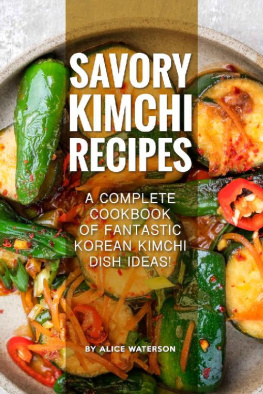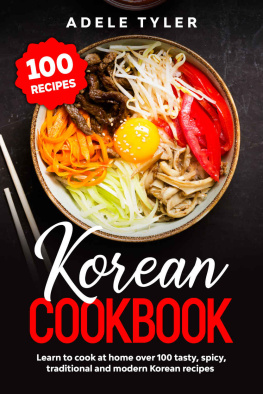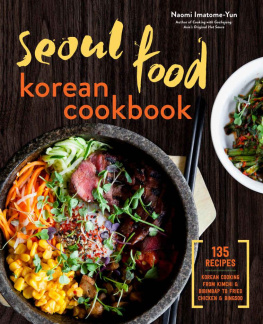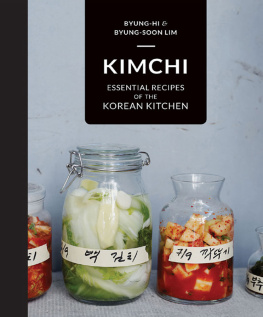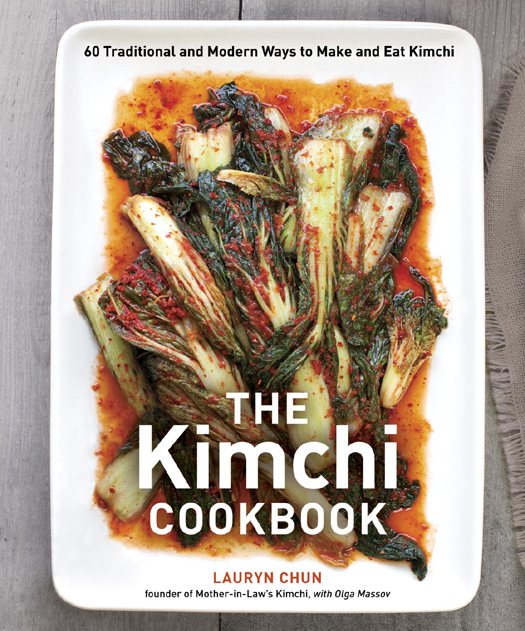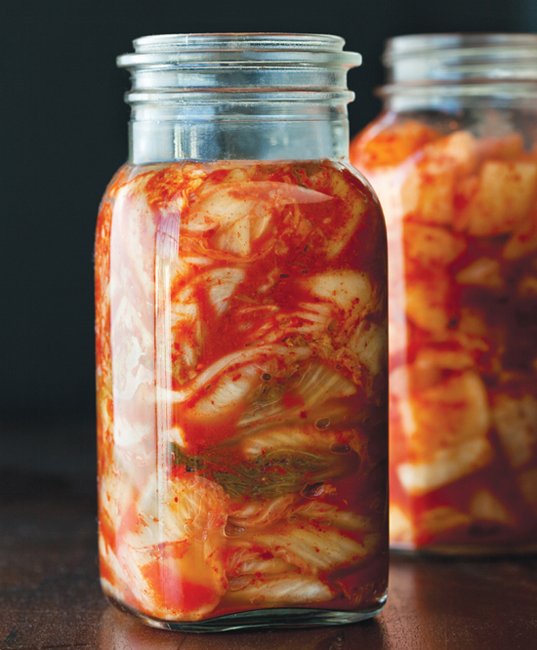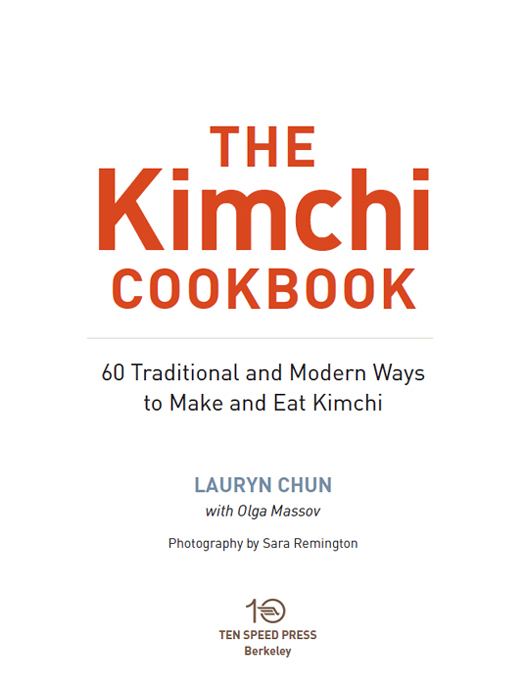Copyright 2012 by Lauryn Chun
Photographs copyright 2012 by Sara Remington
All rights reserved.
Published in the United States by Ten Speed Press, an imprint of the Crown Publishing Group, a division of Random House, Inc., New York.
www.crownpublishing.com
www.tenspeed.com
Ten Speed Press and the Ten Speed Press colophon are registered trademarks of Random House, Inc.
Photographs courtesy Adam Field Pottery
Library of Congress Cataloging-in-Publication Data is on file with the publisher.
eISBN: 978-1-60774-336-1
Food styling by Katie Christ
Prop styling by Jaimi Holker
v3.1
Contents
Acknowledgments
I would like to express my deepest gratitude to my halmoni (maternal grandmother), who instilled in me the foundations of cooking and my earliest memories of food; to my umma (mother), who taught me about the bounty of food and the importance of sourcing the highest-quality ingredients; to my emo (aunt) for always creating family celebrations around food; and to the ajumas (the ladies), and the entire staff at Jang Mo Jip restaurant in Garden Grove, California, who have been feeding everyone since 1989. I feel privileged to have had many enriching culinary and cultural experiences in my life, throughout my travels and among friends with whom Ive shared meals, raised a glass of wine, cooked, and touched the dirt. Also, to the great chefs whove ignited my passion for food, from five-star dining experiences at Bouley, Gotham Bar and Grill, Le Bernardin, Daniel, Gramercy Tavern, the French Laundry, Jean Georges, and Arzak, to my introduction to the world of fine dining working at La Cachette in Los Angeles, to every countryside restaurant I dined at by happenstance in Europe and roadside food vendor I encountered throughout my travels in Southeast Asia. Their common language of food made an indelible impression on me. Each experience became a crucial building block and contributed to this book.
Thanks to my editor, Melissa Moore, for making this book possible with her courage and foresight, and for her patience in listening to my voice and vision even when I couldnt hear myself. Thanks also to Olga Massov, my cowriter, for her enthusiasm for fish sauce, diligence, and teamwork, for keeping me on track in and out of the kitchen, and for letting the words take shape. To Jessica Boucher, Kristina Ratliff, Ryan Urcia, Tattfoo Tan, Bernard Sun, and countless others who, from the very beginning, helped ignite my desire to share kimchi with the world; and to my cousin Cathy Muma for sharing her new kitchen and testing the recipes, Hakyung Choi for all of her insights. Thanks to Betsy Stromberg, art director extraordinaire, and to Sara Remington for her beautiful photographs and enthusiasm, and for assembling a dream team with Katie Christ and Jaimi Holker. I wont forget Saras dedication to our photoshoot, limping with an ice pack wrapped around her knee, yet a smile on her face showing love of all things kimchi. Thanks to Renato DAgostin for my first official portrait and to Adam Field for providing onggi photographs; to Alan Tardi and Steven Hall for their timely feedback. To Norman Roberts for his unyielding patience and encouragement that allowed me to go after my dreams, a heartfelt thank you.
Thanks to Robert LaValva and the entire team and fellow vendors at New Amsterdam Market for providing the stage to be part of the regional, seasonal market community that served as catalyst to share the full story of kimchi. A special thanks to Fany Gerson, Justin V. Barocas, and Tara Q. Thomas for their faith in my story. And to every person and patron who showered me with their curiosity, interest, and excitement about Mother-in-Laws Kimchi and shared their personal stories about how they found their way to kimchi. Thank you for making possible my small dream of changing the world with one jar of kimchi at a time and for helping me to find my voice.
> This photo shows our signature kimchi at various stages of fermentation: the bottom left bowl shows it fresh; the bottom right has been fermented 2 to 3 days; the top left has been fermented 1 week; and the top right has been fermented 1 month.
Introduction
I have been eating kimchi all my life. But I only truly smelled it about three years ago, when I was making kimchi alone for the first time. The vivid aromas suddenly brought me back to my childhood in Seoul, to my maternal grandmother and my earliest memories of food. I must have been about five years old, walking through the woods with my grandmother foraging for wild plants that would turn up at the dinner table; smelling the enticingly intense aroma of freshly roasted soybeans, used for making a fermented soybean paste called doenjang ; tasting the warmth of a freshly laid egg; and watching a chicken from our backyard being butchered. Although we had moderate means, the act of preparing food formed a large part of my childhood, and especially of what gave me comfort. There was a sense of excitement watching my grandmother or mother in the kitchen preparing the food that would play a central role in bringing together the entire family at mealtime.
I also remember watching my grandmother make kimchi with the neighborhood ajumas (a respectful term for maternal figures, like madam or maam) during kimjang , the annual fall cabbage harvest, when I was six years old. From time to time, Id run up to my grandmother, and shed give me small pieces of the inner cabbage leaf with the rolled-up stuffing in them. It was always so special to mea bond of love between us and a preview of the kimchi we would be eating all winter.
Suddenly it all made sensewhy I was so curiously drawn to food and wine, my secret fascination when the deep smell of an aged red wine elicited a faint memory of roasted soybeans, the familiar intense meaty aroma of a properly made veal stock, the musky smell of wine cellars or ripe cheese that made me recall the comforting memories of my childhood in Seoul, Korea. I had come full circle from my Korean roots, through Western traditions, culminating in rediscovering kimchi.
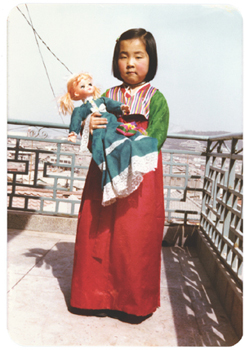
In Korea, kimchi is eaten with every meal. I was about eight years old when my family came to the United States, and, like many immigrant families, we spent a lot of time shopping for food and preparing what was going to be served on the table. There were always two shopping trips: I recall spending entire weekends shopping for Korean ingredients at specialty shops and then visiting typical American grocery stores. Our family dinners showcased my mothers innate ability to create endless delicious meals out of what we bought. While I was adapting to American culture, I was often embarrassed about how pungent Korean food is compared to American food, and I found myself ashamed and reluctant to share Korean traditions. Food was very important to us, and yet Korean food was so different, especially kimchi, so foreign, spicy, and stinky that it seemed as if it had no place in the American kitchen. I couldnt see a bridge between the two cultures.



